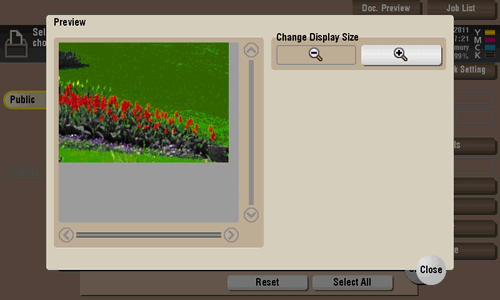
Organize files in a User Box
Operation flow
- Tap [Box].
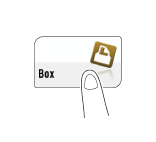
- Select the desired User Box, then tap [Open].
- This example uses the Public User Box for explanatory purposes. To use a Personal User Box or a Group User Box, tap [Personal] or [Group] and select the desired box.
- If the box is password protected, tap [Open] and enter the password.
- You can also open the desired User Box by tapping it twice.
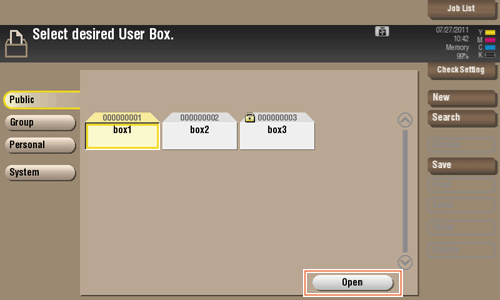
- Select a file and set the desired operation.
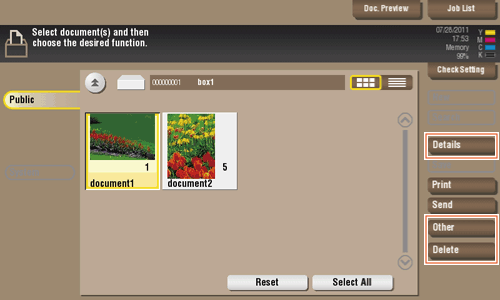
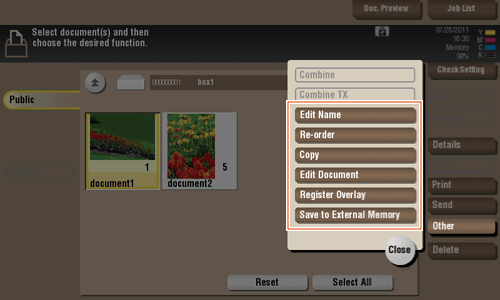
Delete a file
Select a file, then tap [Delete]. The file is deleted. You can select multiple files and delete them simultaneously. Check the file details, then tap [Yes].
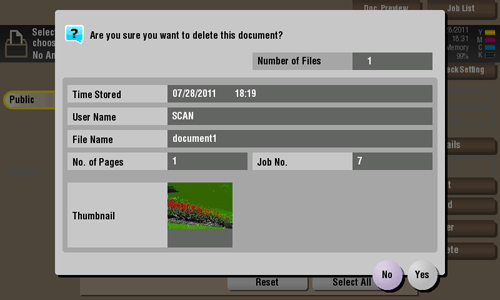
Rename a file
Select a file, then tap [Other] - [Edit Name]. Now you can rename the file. Enter a new name from the Touch Panel.
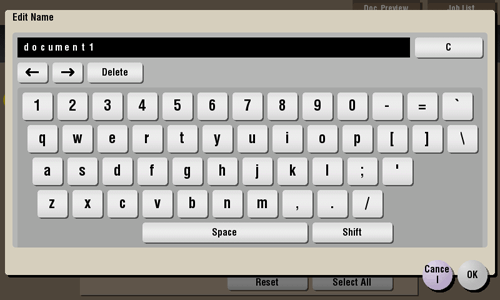
Tips
- Before renaming a file, check the destination server conditions and others.
- You can also rename a file while it is being transmitted.
Move file to another User Box
Select a file, then tap [Other] - [Re-order]. Now you can move the file to another User Box. The destination can be a Public User Box, a Personal User Box, or a Group User Box. Select a destination User Box, then tap [Start] or press the Start key.

Tips
- You do not need to enter the password even if it is specified for the destination User Box.
Copy file to another User Box
Select a file, then tap [Other] - [Copy]. Now you can copy the file to another User Box. Select the destination Public, Personal or Group User Box. Select a destination User Box, then tap [Start] or press the Start key.
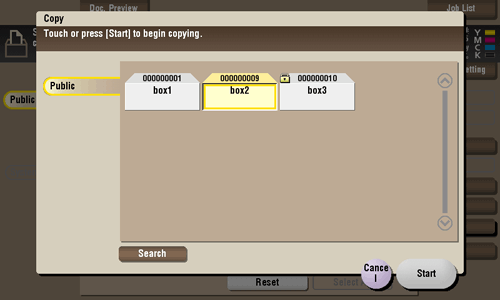
Tips
- You do not need to enter the password even if it is specified for the destination User Box.
Edit a page
Select a file, then tap [Other] - [Edit Document]. Now you can select page of the file to delete or rotate.
- Select a page, and set the edit options.
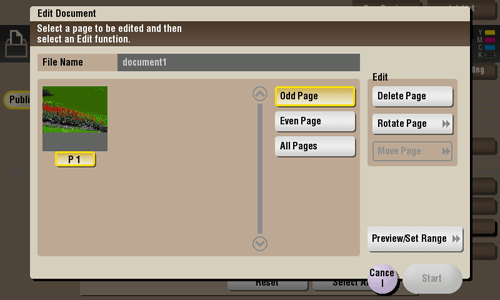
Function Description [Odd Page]Selects odd-numbered pages only.[Even Page]Selects even-numbered pages only.[All Pages]Selects all pages.[Delete Page]Deletes a selected page or pages. For example, you can delete blank pages to reduce the amount of data.[Rotate Page]Rotates a selected page 90 degrees or 180 degrees.When a 2-sided original is scanned, the top and bottom may be reversed page by page or the orientation may be different from the original. In this case, you can rotate and correct the orientation of each page.[Move Page]Reorders pages by moving some of them.Only one page can be moved at a time. Repeat this operation to move two or more pages.- [Preview/Specify by Input]: If a large number of pages are stored, use this option to set the destination to move pages by entering numeric values. Enter a destination page number, and specify to insert the page immediately before or after the destination.
[Preview/Set Range]Sets a range of pages and displays them as preview image. You can also change the display size. - Tap [Start].
- To save your changes, tap [Yes].

Your settings are saved.
Save file in a USB memory
Insert a USB memory device into the USB port of this machine, select a file, then tap [Other] - [Save to External Memory]. Now you can save the file on the USB memory.
- A file storage on a USB memory must first be enabled with the administrator privileges. For details, refer to Here ([Save Document]).
- Files of some USB memory devices may not be recognized correctly. For support of USB memory devices, refer to Here.
- Select a file to save on the USB memory device, then tap [Other] - [Save to External Memory].
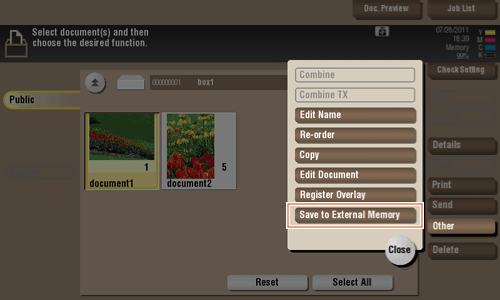
- Set file save options if necessary.
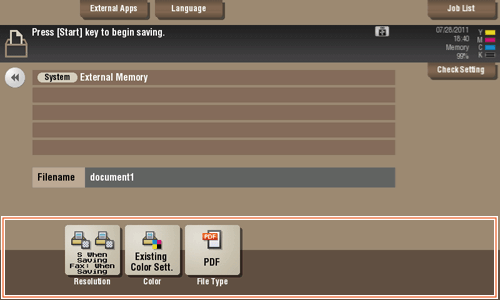
Options Reference ResolutionColorFile Type - Press the Start key.
The file is saved on the USB memory device.
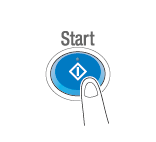
- When the operation is complete, remove the USB memory device from the port of this machine.
Store file as an overlay image
Select a file, then tap [Other] - [Register Overlay]. Now you can store the file as an overlay image.
Once registered, you can compose an overlay image on the original during copy or printing from the PC. Also, you can compose an overlay image onto a User Box file during file printing.
You can register up to 100 overlay images.
- To register an overlay image, select an unregistered key and tap [New].
- To register an overlay image by overwriting an existing one, select the registered key and tap [Overwrite].
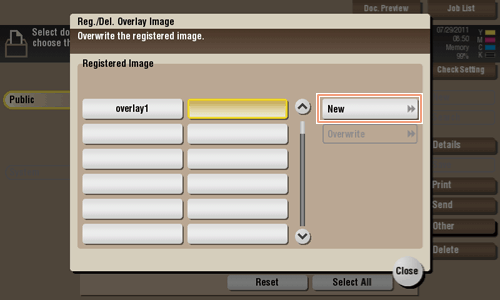
- To register an overlay image by overwriting an existing one, select the registered key and tap [Overwrite].
- Enter a registration name, then tap [OK].
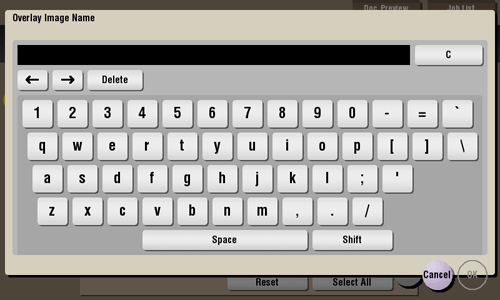
- Set a density and color of the image if necessary, then tap [Start].
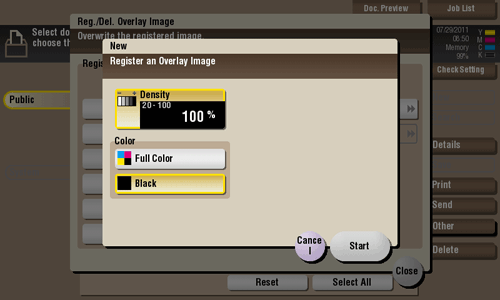
Tips
- If a file consists of multiple pages, the first page is registered as an overlay image.
- Once registered, you can compose an overlay image on the original and copy it by selecting [Application] in Copy mode and [Registered Overlay]. Also, when you print a file from a User Box, you can compose an overlay image to the file and print it by selecting [Application] - [Registered Overlay].
Check the file information
Select a file, then tap [Details] to check the detailed file information.
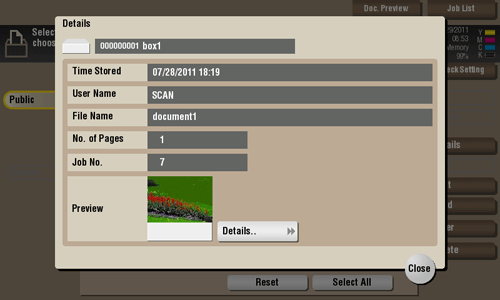
Tap [Details..], to preview the file image.
